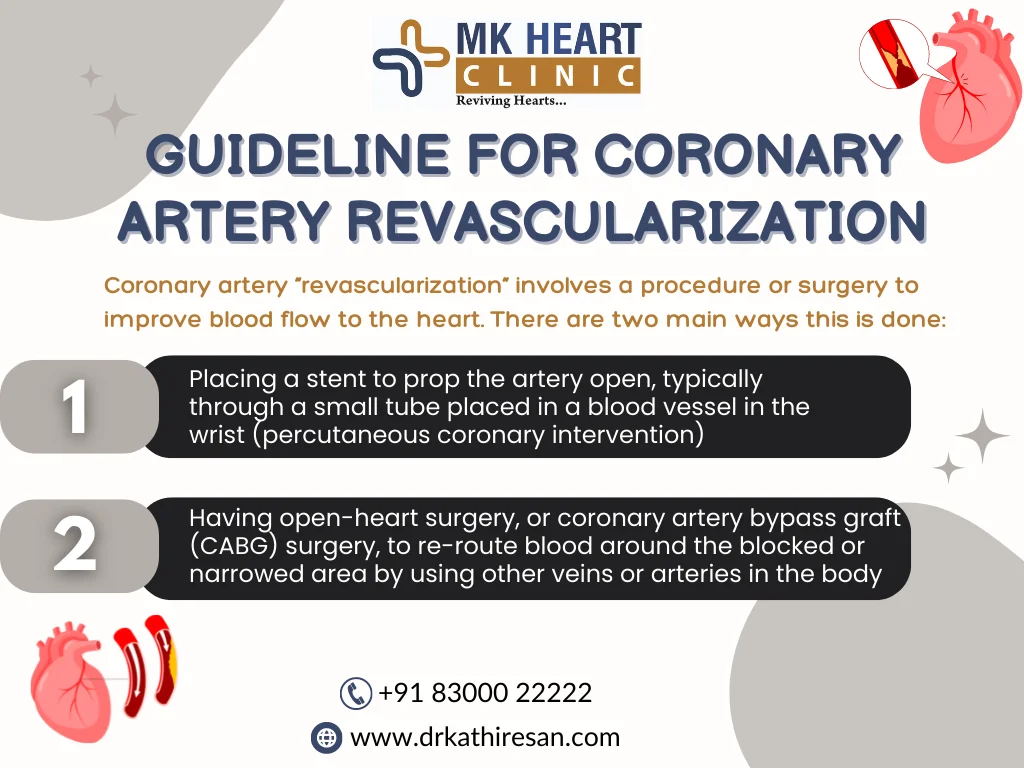Coronary Revascularization Surgery (CRS) can refer to two different surgeries with vastly different goals, Coronary Artery Bypass Grafting (CABG) and Percutaneous Coronary Intervention (PCI). The most common goal of either procedure is to treat patients with heart attacks or other life-threatening coronary heart diseases that could result in death if not treated quickly.
It is necessary to understand both types of surgery and their differences before making any decisions about CRS treatments. This article will explore the different types of CRS and how each procedure aims to keep your heart beating regularly and healthily.

What is Coronary Revascularization Surgery?
Coronary Revascularization Surgery is one of the most common ways to treat coronary artery disease (CAD). It involves opening the blocked arteries using interventional techniques to restore blood flow to the heart muscle.
Coronary Revascularization is the process of surgically opening blocked or narrowed blood vessels in the heart which reduces the risk of heart attack and subsequent loss of life by reducing the overall burden of arterial plaque.
Coronary artery disease (CAD) occurs when the coronary arteries, supplying the heart with oxygen-rich blood, become clogged due to a build-up of fat, cholesterol, and calcium deposits on their walls, causing them to narrow and reducing blood flow throughout the heart muscle.
What is Hybrid Coronary Revascularization surgery?
The Coronary Artery Revascularization (CAS) procedure removes blockages in coronary arteries to increase blood flow to the heart. The CAS goal is to help restore heart function. There are two different types of Cardio-Thoracic Surgery operations:
Minimally invasive endovascular procedures
Traditional open-heart surgery
The Importance of the Surgery
Hybrid coronary revascularization surgery, also known as off-pump coronary artery bypass grafting (OPCAB), is done to reduce complications and improve survival rates. This type of surgery offers many benefits that traditional coronary artery bypass grafting (CABG) does not, including less pain and decreased risk of infection.
The Benefits of the Surgery
Hybrid coronary artery revascularization surgery is an innovative, minimally invasive surgical procedure that provides patients with a lower risk of complications and enhanced recovery. The procedure combines two minimally invasive procedures: –
- Percutaneous coronary intervention (PCI)
- Atherectomy – to restore blood flow to blocked heart arteries.
Why it is the Best Option?
The term hybrid in coronary artery revascularization (CABG) generally refers to a surgical procedure that combines components of conventional CABG and percutaneous coronary intervention (PCI).
It has been shown to offer several benefits, including lower risk for death and major adverse cardiac events, reduced hospital length of stay, and lower cost. The hybrid procedure can be performed either under local anesthesia or general anesthesia with intravenous sedation.
Surgeons may also choose to perform it as an out-of-hospital procedure in a catheterization laboratory. Patients who have not yet had heart bypass surgery but who suffer from blocked arteries often choose this type of an operation because it is less invasive than conventional coronary bypass surgery.
In addition, the recovery period after hybrid coronary artery revascularization may be much shorter than after traditional bypass procedures since there are no cuts made on the chest wall and no cardiopulmonary bypass equipment is required. As a result, patients are discharged sooner and able to return to work faster.
When one can need Coronary Revascularization Surgery?
A heart attack is a medical emergency that needs immediate treatment. If you have had a heart attack, you know the importance of receiving coronary revascularization surgery as soon as possible.
There are two main types of coronary artery disease: stable and unstable: –
Stable Coronary Artery Disease (SCAD) is a type of coronary artery disease that does not progress down the coronary artery. SCAD is caused by calcification of plaque. The condition typically does not progress to heart attacks or unstable angina. Stable coronary artery disease is a disease in which coronary arteries become hardened without being blocked.
Unstable coronary artery disease includes angina and myocardial infarction (heart attack). Angina is chest pain or discomfort that occurs when the heart muscle does not get enough blood flow, while myocardial infarction can be fatal if left untreated.
To prevent future complications, you need to undergo coronary revascularization surgery as soon as possible.
Why MK Heart Clinic is Best when it comes to coronary revascularization surgery?
MK Heart Clinic is the leading and best heart clinic in Chennai. They are known for providing the best care to patients. The clinic has been providing a range of services to patients, which includes coronary revascularization surgery.
The doctor at MK Heart Clinic – Dr. M. Kathiresan, is highly qualified and experienced in this field. He provides high-quality services to his patients and has received awards for their excellent work in coronary revascularization surgery.
This clinic is best when it comes to treating coronary revascularization surgery for: –
- Cost-affordable treatment
- State of art ambiance
- Qualified doctors
- Done coronary artery revascularization surgery with a 100% Success rate
- Well-equipped equipment
This Clinic is the best for all these above reasons and is one of the top-notch heart clinics offering comprehensive and complete care in coronary revascularization surgery.
Conclusion
If you are undergoing this procedure, this blog will surely give you a brief idea about coronary artery revascularization surgery! MK Heart Clinic offers high-quality Coronary Revascularization Surgery that can save you from life-threatening death.



